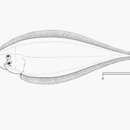Morphology
provided by Fishbase
Dorsal soft rays (total): 125; Analsoft rays: 100
Trophic Strategy
provided by Fishbase
Found on sandy bottoms. Feeds on benthic invertebrates.
- Recorder
- Drina Sta. Iglesia
Biology
provided by Fishbase
Found on sandy bottoms (Ref. 30573). Feeds on benthic invertebrates (Ref. 30573).
Comprehensive Description
provided by Smithsonian Contributions to Zoology
Cynoglossus acutirostris Norman
Cynoglossus (Areliscus) acutirostris Norman, 1939:104, fig. 35 [type-locality: Gulf of Aden].
DESCRIPTION.—Based on 11 specimens, 182.0–238.0 mm SL, including lectotype and paralectotypes of C. acutirostris.
Depth of body 26.29–30.53 (M = 28.40), length of head 23.11–27.47 (M = 26.04) percent of standard length. Diameter of eye 6.14–9.71 (M = 7.95), interorbital space rather narrow, 0.91–3.88 (M = 1.92) percent of length of head. Two nostrils on ocular side, anterior nostril tubular in front of fixed eye, posterior nostril simple, immediately in front of interorbital space. Snout acutely pointed, 37.74–48.54 (M = 43.46) percent of head; rostral hook rather long, reaches below anterior border of fixed eye. Maxillary extending beyond fixed eye; angle of mouth extending to below vertical from posterior border of fixed eye or just beyond, much nearer to branchial opening than to tip of snout, tip of snout to angle of mouth 52.83–65.05 (M = 58.40), angle of mouth to branchial opening 35.79–45.28 (M = 39.90) percent of length of head.
Scales: Cycloid on ocular side with ctenoid scales posteriorly; cycloid on blind side.
Lateral-Line System: Three lateral lines on ocular side, both dorsolateral and ventrolateral lines slightly undulating and entering dorsal and anal fins, respectively, at a very short distance from caudal base; midlateral line with 84–92 (M = 87) scales, 18–20 (M = 19) scales between them. No lateral line on blind side.
Interlinear scale rows 18 19 20
Frequencies 5 4 2
Fins: Dorsal with 110 rays, anal with 94 rays, caudal 10 in 1 specimen (radiograph).
Vertebrae: 58, comprising 9 abdominal and 49 caudal elements in 1 specimen (radiograph).
Coloration: Upper side uniformly brownish, lower whitish in preserved specimens.
Size: Largest specimen examined, 254 (238 + 16) mm, is one of the type specimens from Gulf of Aden.
DISTRIBUTION.—Gulf of Aden; trawled from a depth of about 120 fms.
DIAGNOSIS AND
- bibliographic citation
- Menon, A. G. K. 1977. "A systematic monograph of the tongue soles of the genus Cynoglossus Hamilton-Buchanan (Pisces, Cynoglossidae)." Smithsonian Contributions to Zoology. 1-129. https://doi.org/10.5479/si.00810282.238
Cynoglossus acutirostris: Brief Summary
provided by wikipedia EN
Cynoglossus acutirostris, commonly known as the Sharpnose tongue sole is a species of tonguefish. It is commonly found in sandy waters of the western Indian Ocean, particularly the Red Sea and the Gulf of Aden.
- license
- cc-by-sa-3.0
- copyright
- Wikipedia authors and editors

